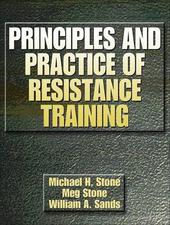
|
Principles and Practice of Resistance Training
Hardback
Main Details
| Title |
Principles and Practice of Resistance Training
|
| Authors and Contributors |
By (author) Michael Stone
|
|
By (author) Margaret Stone
|
|
By (author) William A. Sands
|
| Physical Properties |
| Format:Hardback | | Pages:384 | | Dimensions(mm): Height 279,Width 216 |
|
| Category/Genre | Sports training and coaching |
|---|
| ISBN/Barcode |
9780880117067
|
| Classifications | Dewey:613.71 |
|---|
| Audience | | Undergraduate | | Postgraduate, Research & Scholarly | | Professional & Vocational | |
|---|
| Illustrations |
26 Halftones, black and white; 134 Illustrations, black and white
|
|
Publishing Details |
| Publisher |
Human Kinetics Publishers
|
| Imprint |
Human Kinetics Publishers
|
| Publication Date |
9 March 2007 |
| Publication Country |
United States
|
Description
Principles and Practice of Resistance Training represents a true breakthrough in planning and monitoring strength training programs. This research-based book details how to systematically examine the physical, physiological, and biomechanical parameters associated with crafting resistance training programs to improve sport performance and strength and power in athletes. The authors bring together more than 100 collective years of teaching, conducting research, and coaching national- and international-level athletes to share their unique insights concerning adaptations to strength and conditioning.The text is written in a manner that challenges professionals while remaining accessible to advanced coaches. It begins by presenting readers with an understanding of basic science. This scientific foundation allows readers to formulate a sound training process that is more likely to produce the desired short- and long-term results. Next, the text examines how to test, monitor, and evaluate adaptations to various types of training programs. It emphasizes the significance of appropriately monitoring training programs to identify elements of the program to adjust so the goals of clients or athletes are more effectively and efficiently achieved. Finally, the authors discuss exercise selection and present a practical example so readers can learn to apply the information in the text to build their own training programs. Each chapter is written in a "stand-alone" manner so that readers can refer back to the material as needed. Principles and Practice of Resistance Training also explores key questions that currently have no clear, scientifically proven answers. For these issues, the authors offer reasoned, speculative explanations based on the best available information and data-including anecdotal evidence- intended to stimulate additional observation and research that will eventually offer a clearer understanding and resolution of the issues involved. In sharing their personal experiences as coaches and research scientists, the authors are able to address issues that are not normally dealt with in academic programs. Principles and Practice of Resistance Training is far more than a general guide for strength training. It is an in-depth exploration of the science behind the training. Armed with the scientific understanding and the tools to put that information into practice, you will be able to develop training programs that help your athletes or clients excel.
Author Biography
Michael H. Stone, PhD, is currently the director of the exercise and sports science laboratory in the department of kinesiology, leisure, and sport sciences at East Tennessee State University. Prior to this, Dr. Stone was the head of sport physiology for the United States Olympic Committee (USOC) and the chair of sport at Edinburgh University in Edinburgh, Scotland. He is also an adjunct professor at Edinburgh University; Edith Cowan University in Perth, Australia; and Louisiana State University in Shreveport. Dr. Stone's service and research interests are primarily concerned with physiological and performance adaptations to strength and power training. He has more than 135 publications in reviewed journals and has contributed chapters to several texts in the areas of bioenergetics, nutrition, and strength and power training. He helped form the National Strength and Conditioning Association (NSCA) as well as the British Strength and Conditioning Association. Dr. Stone was the 1991 NSCA Sport Scientist of the Year and was awarded the NSCA Lifetime Achievement Award in 2000. He has coached several international- and national-level weightlifters and throwers in both the United States and Great Britain.Meg Ritchie Stone, MS, is the director of the Sports Performance Enhancement Consortium and assistant track coach at East Tennessee State University. Stone holds the NCAA collegiate records in shot and discus and was a two-time Olympian in the discus for Great Britain. She also won a gold medal in the 1982 Commonwealth games. Stone was the first female to hold the position of head strength and conditioning coach at a Division I football playing institution, and she fulfilled that role at both the University of Arizona and Texas Tech. She also coached track and field at Appalachian State University and in 1999 she returned to her native Scotland to become the national track and field coach-the first woman in Europe to hold a national coaching position. Stone has coached several international-level athletes, including four Olympians, in both the United States and Great Britain. She has also coached many athletes who later played in the NBA, MLB, and NFL. In addition, Stone has worked extensively with road cyclists and Paralympic groups through Carmichael Training Systems and the USOTC in Colorado Springs. William A. Sands, PhD, is head of sport biomechanics and engineering for the United States Olympic Committee. He has served as senior sport physiologist at the Lake Placid Olympic Training Center as well as the physiologist for USA Track and Field and USA Diving. He has coached Olympic and world championship gymnasts and served as chair for the United States Elite Coaches Association for Women's Gymnastics. Dr. Sands is on the board of directors for the International Society of Biomechanics in Sports and is a member of the American College of Sports Medicine.
|